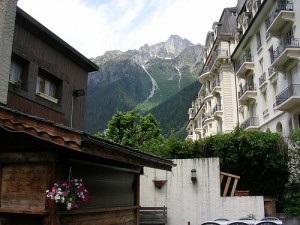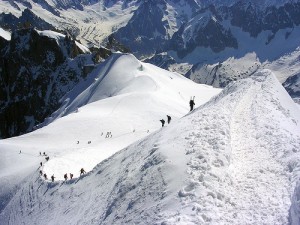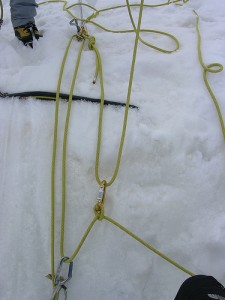
The Brévent, from Chamonix
If you live away from the mountains, the only time you hear about a climbing accident is if something big goes down on Mt. Everest, or if the Today Show picks up an amazing tale of survival from a fourteener hike gone wrong. But when you live in the mountains, climbing and skiing accidents appear in your local news on a regular basis.
We can’t easily read the local news here, but we heard helicopters all day on Friday. We woke to the rat-tat-tat in the morning, saw them when we hiked on the northwest side of the valley in the afternoon, and by evening, when they were still going, we wondered whether they were having an epic training day or if something bad went down.
There was an accident. Jeremy spotted a blurb about it Saturday on ESPN:
“Karine Ruby, a former Olympic snowboarding champion who had been training to become a mountain guide, died Friday in a climbing accident on Mont Blanc. She was 31. Ruby was roped to other climbers when she and some members of the group fell into a deep crack in the glacier on the way down the mountain…”
But we didn’t have time to ponder it, because–timely–that evening we were sorting gear and loading our packs to spend the next day out with guide Michael Silitch learning how to travel safely on the glaciers above Chamonix.
Last year we climbed the Cosmiques Arete with Michael (the photos he snapped along the way are here–by the way, how do guides take such great photos and give clients safe belays at the same time?!?). Neither of us have experience with glacier travel, so this year we wanted to learn safety basics so we can start doing easy alpine climbs on our own.
Sunday morning broke sunny atop the Aiguille du Midi cable car station, and from the observation decks we could see that the Vallée Blanche was crawling with people.

The view from the Aiguille du Midi
Across the valley, another swarm was either switchbacking up to or skiing down from a bowl on Mont Blanc du Tacul–which Michael pointed out was an avalanche terrain trap, and then directed our attention to the rows of tipping seracs most of the way up the mountain above. As if on cue, we heard a roar from another direction and spotted an avalanche below us on the Midi, and as it thundered on, Michael explained that seracs can fall at any time, day or night.
Great. Or as they like to say here, super.
We spiked up and tied in for the daunting trip down a ridge from the station to the Vallée Blanche. The soft snow started balling up under my crampons, and Michael pointed out that they’re really only good for ice climbing, not alpine climbing. And by the way, our ice axes aren’t quite right either. Gah. I need to make friends with someone at Grivel or Petzl.
Michael whipped out a snow probe and staked out a safe area on a flat spot between the ridge and the bergschrund (the Vallée Blanche is a glacier). Below, the climbers and skiers became the subjects of our class. A few people were doing everything right (“See that team of two? They’re far apart, and there’s no slack in the rope.”) but it seemed like a lot of people were doing everything wrong (“These people have way too much slack in the rope; those people are standing around too close together; that guy is alone without skis.”).
“Some of the French are kind of laissez-faire about this stuff,” Michael said. Eh, oui: It seemed like there was a lot of scary stuff going on.
Michael pointed out the area where Friday’s accident happened and said there wasn’t much information about it–everyone in the party died–so it was tough to analyze what went wrong. There are huge crevasses up there, though, so he wondered if they had gathered too close together on a snow bridge over a crevasse, and when it broke, it took all of them.
As people passed around us on their way to and from the cable car station, we offered bonjours, and Michael sometimes offered a more brotherly salut to other guides. Karine was a friend of his, he said, and a beloved member of the community. She was trying to become the second woman in the exclusive (and quite traditional) Compagnie des Guides de Chamonix.

Ridge to the Vallée Blanche from the Aiguille du Midi
Not to be presumptive, but I suspect it’s best not to dwell on death, even the death of a friend, when your profession is to guide people through deadly terrain on a regular basis, and he didn’t–he moved on to the text topic. But it’s staring you in the face in a place like this. In fact, as Michael was talking us through how to set up rope teams, a party that was heading back up to the station took a long break behind us because one of its members seemed to be having mountain sickness of some sort. He was on his back, rolling around and moaning. One of his buddies put his crampons on for him.
As we transitioned the rope to the appropriate length to walk down onto the glacier, Michael said the man probably had cerebral edema.
“Really?” we said.
“Yeah, people come up from Paris and go right to 12,000 feet,” he said. Ah. Just like back home in Colorado, where people fly in from Chicago to ski at 11,000 feet and end up with Acute Mountain Sickness.
Clouds had been building from the Italian side of the range all day, but by mid afternoon, gray clouds rose from the Chamonix side, too.

How to haul someone out of a crevasse: Learn to build pulleys
A few snowflakes blew in as I puzzled over the pulley system Michael had built to rescue his pack–our faux fallen climber. I’m extra paranoid about lightning after an experience we had last summer in the Indian Peaks, and we all thought it would be good to avoid yet another mountain hazard.
Back at the Aiguille du Midi station, we packed up or covered our sharp objects for the journey back down to Chamonix. The tourists are aggressive when queueing up for the cable cars (even to people carrying ice axes), and at 125 lbs., I’m often jostled about by the crowd once we’re squeezed into the car. On one leg of this journey, I was backed up to a large man wearing a tiny pack, which you’re supposed to remove before you get in the cable car. He removed his pack while I was pressed against it. The French couple next to me giggled in shock and gestured for me to jab him with my elbows. I wished my glacier-inappropriate ice axe was accessible. The tourists, it turns out, are the final hazard you have to deal with when climbing in the Alps.
This summer, I’m conducting a work/play experiment in the Alps. I’ve moved my home office from Colorado to Chamonix, a lovely but sometimes insanely touristy town at the foot of Mont Blanc. This post is the second in a series about temporarily living and working in a premiere trekking and climbing destination–and another country.

Sounds like an amazing summer, Jenn! Will your adventures be chronicled in any particular magazine?
Welcome to Chamonix, Jenn Fields…
Twitter let me know you and your man have arrived for the Summer….
Chamonix is a wonderful place…. full of beauty, inspiration, talent and death. It is the “extreme capital of Europe”. after all…. people push their limits here, accidents happen, people die…. Other people have a fantastic time sampling the Tartiflette and looking at the Mer du Glace.
Enjoy your summer. Stay safe… and keep the great blog posts coming!
kind regards,
Leighton at the Maison Jaune.
Jenn,
I’m loving reading your writing from your kitchen table over lunch.
Nice to picture you where you are, while I am where you usually are. Rainy and grey here, nice for settling into your wonderful home.
I look forward to the next post.
Paige
Man, I hope your mom is not reading these… 🙂